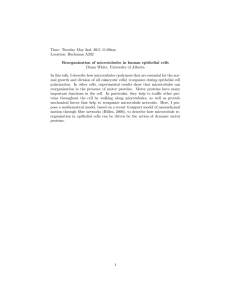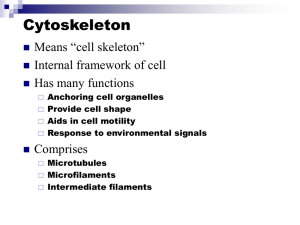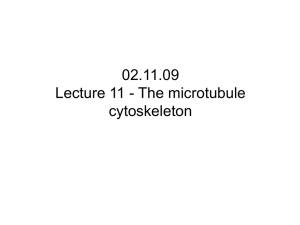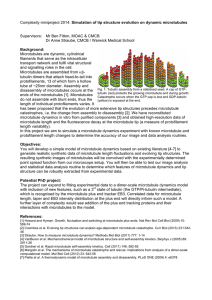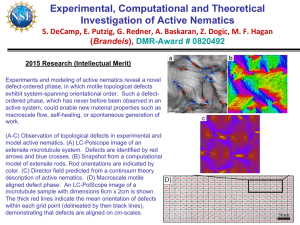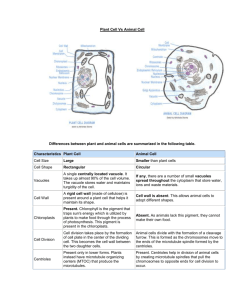LETTER Spontaneous motion in hierarchically assembled active matter
advertisement
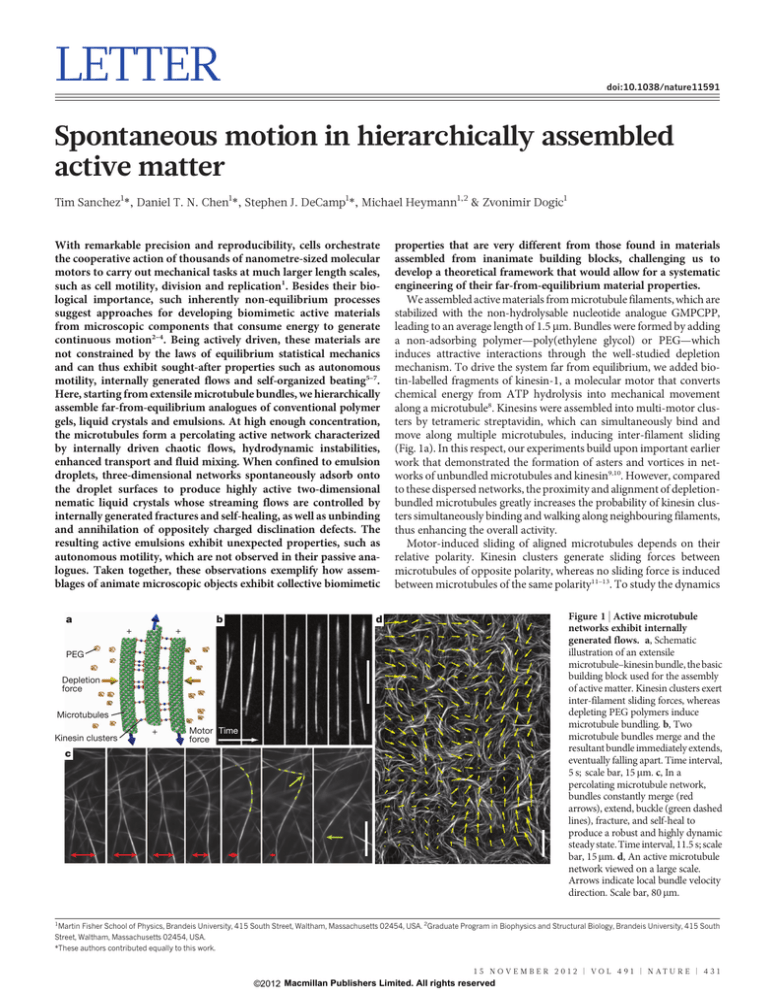
LETTER doi:10.1038/nature11591 Spontaneous motion in hierarchically assembled active matter Tim Sanchez1*, Daniel T. N. Chen1*, Stephen J. DeCamp1*, Michael Heymann1,2 & Zvonimir Dogic1 With remarkable precision and reproducibility, cells orchestrate the cooperative action of thousands of nanometre-sized molecular motors to carry out mechanical tasks at much larger length scales, such as cell motility, division and replication1. Besides their biological importance, such inherently non-equilibrium processes suggest approaches for developing biomimetic active materials from microscopic components that consume energy to generate continuous motion2–4. Being actively driven, these materials are not constrained by the laws of equilibrium statistical mechanics and can thus exhibit sought-after properties such as autonomous motility, internally generated flows and self-organized beating5–7. Here, starting from extensile microtubule bundles, we hierarchically assemble far-from-equilibrium analogues of conventional polymer gels, liquid crystals and emulsions. At high enough concentration, the microtubules form a percolating active network characterized by internally driven chaotic flows, hydrodynamic instabilities, enhanced transport and fluid mixing. When confined to emulsion droplets, three-dimensional networks spontaneously adsorb onto the droplet surfaces to produce highly active two-dimensional nematic liquid crystals whose streaming flows are controlled by internally generated fractures and self-healing, as well as unbinding and annihilation of oppositely charged disclination defects. The resulting active emulsions exhibit unexpected properties, such as autonomous motility, which are not observed in their passive analogues. Taken together, these observations exemplify how assemblages of animate microscopic objects exhibit collective biomimetic a + + b properties that are very different from those found in materials assembled from inanimate building blocks, challenging us to develop a theoretical framework that would allow for a systematic engineering of their far-from-equilibrium material properties. We assembled active materials from microtubule filaments, which are stabilized with the non-hydrolysable nucleotide analogue GMPCPP, leading to an average length of 1.5 mm. Bundles were formed by adding a non-adsorbing polymer—poly(ethylene glycol) or PEG—which induces attractive interactions through the well-studied depletion mechanism. To drive the system far from equilibrium, we added biotin-labelled fragments of kinesin-1, a molecular motor that converts chemical energy from ATP hydrolysis into mechanical movement along a microtubule8. Kinesins were assembled into multi-motor clusters by tetrameric streptavidin, which can simultaneously bind and move along multiple microtubules, inducing inter-filament sliding (Fig. 1a). In this respect, our experiments build upon important earlier work that demonstrated the formation of asters and vortices in networks of unbundled microtubules and kinesin9,10. However, compared to these dispersed networks, the proximity and alignment of depletionbundled microtubules greatly increases the probability of kinesin clusters simultaneously binding and walking along neighbouring filaments, thus enhancing the overall activity. Motor-induced sliding of aligned microtubules depends on their relative polarity. Kinesin clusters generate sliding forces between microtubules of opposite polarity, whereas no sliding force is induced between microtubules of the same polarity11–13. To study the dynamics Figure 1 | Active microtubule networks exhibit internally generated flows. a, Schematic illustration of an extensile microtubule–kinesin bundle, the basic building block used for the assembly of active matter. Kinesin clusters exert inter-filament sliding forces, whereas depleting PEG polymers induce microtubule bundling. b, Two microtubule bundles merge and the resultant bundle immediately extends, eventually falling apart. Time interval, 5 s; scale bar, 15 mm. c, In a percolating microtubule network, bundles constantly merge (red arrows), extend, buckle (green dashed lines), fracture, and self-heal to produce a robust and highly dynamic steady state. Time interval, 11.5 s; scale bar, 15 mm. d, An active microtubule network viewed on a large scale. Arrows indicate local bundle velocity direction. Scale bar, 80 mm. d PEG Depletion force Microtubules Kinesin clusters + Motor Time force c 1 Martin Fisher School of Physics, Brandeis University, 415 South Street, Waltham, Massachusetts 02454, USA. 2Graduate Program in Biophysics and Structural Biology, Brandeis University, 415 South Street, Waltham, Massachusetts 02454, USA. *These authors contributed equally to this work. 1 5 NO V E M B E R 2 0 1 2 | VO L 4 9 1 | N AT U R E | 4 3 1 ©2012 Macmillan Publishers Limited. All rights reserved RESEARCH LETTER c 104 5.6 mM 154 μM 120 μM 103 73 μM 57 μM 43 μM 102 28 μM 2.0 23 μM 18 μM 101 14 μM 0 μM 100 0.8 0.6 0.4 0.2 1.0 10−1 10−2 10−1 1.2 1.0 <V(R)•V(0)> <|V(0)|2> b MSD (μm2) a example, kinesin walking velocity is tuned by ATP concentration, allowing us to examine how active flows depend on the underlying microscopic dynamics (Supplementary Video 4)8. To quantify fluid flow, we embedded micrometre-sized beads into the BANs (Fig. 2a, Supplementary Video 5). The beads were coated with a polymer brush to suppress their depletion-induced binding to microtubule bundles. In the absence of ATP, the tracer particles probed a passive viscoelastic network, and their mean square displacement (MSD) was sub-diffusive (Fig. 2b). At intermediate ATP concentrations, MSDs became super-diffusive at longer timescales, while remaining sub-diffusive at shorter timescales; indicating that the beads were being advected by internally generated flows. Similar effects were observed for beads suspended in active bacterial baths22. At saturating ATP concentrations, MSDs were essentially ballistic; that is, beads moved along straight paths. At longer timescales, all MSDs should become diffusive; however, this requires measuring long trajectories that are not accessible to our imaging system. We also examined the spatial structure of internally generated fluid flow by calculating the equal-time velocity–velocity correlation function between bead pairs, ,V(R) .V(0)., where R is their lateral separation (Fig. 2c). The correlation functions decayed exponentially and become anti-correlated at approximately 200 mm. The decay of ,V(R) .V(0). taken at different ATP concentrations collapsed onto a universal curve when rescaled by the peak velocity ,V(0)2., revealing that the spatial structure of the internally generated fluid flow is independent of kinesin velocity (Fig. 2c). For saturating ATP concentrations, the average bead velocity (,2.2 mm s21) was approximately three times the maximum kinesin velocity8. Previous work on unbundled microtubule–motor mixtures described temporally transient dynamics before settling into a quasi-static state consisting of either aster or vortex defects10. BANs are fundamentally different at both macroscopic and microscopic scales. At macroscopic scales, BANs exhibit steady-state permanent flows that persist for days and are only limited by ATP availability and stability of the constituent proteins. At microscopic scales, BAN dynamics is driven by cascades of microtubule bundles extending, buckling, self-fracturing and self-healing. Such unique dynamics inherently demands the presence of a depletion agent, absent in previous studies. Furthermore, BANs are very robust, exhibiting the same behaviour over a wide range of microscopic control parameters (0.4% to 10% PEG, 0.5–5 mg ml21 microtubules, 10 mM to 3 mM ATP, 1.5–120 mg ml21 kinesin). Finally, as we show next, BANs under confinement exhibit qualitatively distinct behaviour from those of unbundled microtubule–kinesin networks23. 100 0.0 101 102 Timelag (s) Figure 2 | ATP concentration controls dynamics of active microtubule networks. a, Tracer particles embedded in BANs indicate local fluid flow. Trajectories of the particles (red paths) reveal highly non-Brownian motion. Scale bar, 80 mm. b, Mean square displacements of tracer beads plotted as a function of time for different ATP concentrations (colour-coded on the figure). Lines indicate a diffusive exponent of 1.0 and a ballistic exponent of 2.0. c, Normalized spatial velocity–velocity correlation functions as a function of 103 –0.2 10 2.8 mM 1.3 mM 650 μM 325 μM 235 μM 198 μM 154 μM 120 μM 94 μM 73 μM 57 μM 43 μM 28 μM 23 μM <V(R)•V(0)> (μm2 s–2) of active bundles, we confined a dilute suspension of microtubule bundles to quasi-two-dimensional (2D) chambers. No sliding is observed for isolated bundles, indicating that they are locally polarity sorted. However, owing to passive diffusion, quasi-static bundles occasionally encounter each other and join as a result of attractive depletion interactions. Merging bundle domains are equally likely to have the same or opposite polarity, the latter case resulting in their relative sliding and even bundle disintegration (Fig. 1b). In one case, two polarity-sorted bundles met with an initial anti-parallel orientation and promptly slid off each other. Subsequently, they rotated by 180u and rebound with relative orientation opposite to their original, and this time no sliding occurred (Supplementary Video 1). Overall, the active microtubule bundles almost exclusively exhibited extensile behaviour, in contrast to actin/myosin bundles, which preferentially contract14. Consequently, as we show next, gels constituted from extensile microtubule bundles are strikingly different from actin/myosin gels, which exhibit bulk contraction15,16. Increasing the concentration of extensile microtubule bundles led to the formation of percolating bundled active networks (BANs) with unique properties (Methods). For example, in contrast to classical polymer gels, which respond only passively to externally imposed stresses, BANs exhibited internally generated fluid flows (Fig. 1d, Supplementary Video 2). These highly robust spatiotemporally chaotic flows occurred throughout millimetre-sized samples and can persist for up to 24 h, limited only by the available chemical fuel (ATP) produced through the regeneration system. To gain insight into the microscopic dynamics that drive the formation of such patterns, we visualized constituent microtubule bundles at high magnification. Similar to the dilute case, we observed extension of bundles due to internal polarity sorting. However, in contrast to the dilute case, the extending microtubule bundles were now connected to a viscoelastic network. This caused them to buckle at a critical length scale17 and subsequently fracture into smaller fragments which quickly recombined with surrounding bundles of random relative polarity, generating further extension. Thus, BAN dynamics are determined by cycles of microtubule bundles undergoing polarity sorting, extension, buckling, fracturing and subsequent recombination (Fig. 1c, Supplementary Video 3). The emergent patterns, involving thousands of microtubule bundles, are qualitatively similar to those observed in other non-equilibrium systems such as swarming bacteria or swimming spermatozoa18,19. Theoretical coarse-grained models of extensile rod suspensions predict the occurrence of hydrodynamic instabilities that may underpin such large-scale collective effects20,21. Being constructed from the bottom up, the properties of BANs are easily controlled and optimized. For 6 4 2 0 10 100 R (μm) 100 R (μm) 1,000 1,000 lateral separation for varying concentrations of ATP (colour-coded on the figure). The velocities were determined using equal time intervals of 5 s. When normalized by the peak velocity ,V(0)2., the correlation functions rescale onto a universal curve, revealing a characteristic length scale that is independent of ATP concentration. Inset, bare spatial correlation functions reveal that average velocity depends on ATP concentration. 4 3 2 | N AT U R E | VO L 4 9 1 | 1 5 NO V E M B E R 2 0 1 2 ©2012 Macmillan Publishers Limited. All rights reserved LETTER RESEARCH It is well known that with increasing concentration, rod-like molecules undergo a transition to a nematic liquid-crystalline phase. To explore this regime we created a flat 2D oil–water interface stabilized with a surfactant, with BANs being dispersed in aqueous phase. Over time extensile microtubule bundles adsorbed onto the PEG brush formed by the surfactant molecules, eventually covering the entire surface with a dense liquid-crystalline monolayer of locally aligned bundles. The adsorbed 2D layer constituted an active microtubule liquid-crystalline phase, characterized by fast streaming flows and defect unbinding (Supplementary Video 6). Further information about the nature of active microtubule liquid crystals can be garnered by examining the structure and dynamics of their defects. In general, active liquid crystals can have either nematic symmetry24,25 (as found in monolayers of amoeboid cells or vertically shaken monolayers of granular rods26,27) or polar symmetry (which is found in motility assays at high concentrations5,28). Polar liquid crystals form vortex and aster defects5,29. In contrast, we found that active microtubule liquid crystals form disclination defects of charge 1/2 or -1/2, implying the presence of nematic symmetry (Fig. 3a-c). This is expected because the basic building blocks of these materials are symmetrically extensile microtubule bundles. In equilibrium liquid crystals, defects are largely static structures whose presence is determined by either internal frustrations or external boundary conditions. In contrast, defects in active microtubule nematics exhibited unique spatiotemporal dynamics. They were created as uniformly aligned nematic domains extend, buckle and internally self-fracture (Fig. 3d), similar to the dynamical cascades a d of microtubule bundles in 3D active networks. Once created, a fracture line terminated with a pair of oppositely charged disclination defects. Eventually, even as the fracture self-healed, the defects remained unbound and streamed around until eventually annihilating with oppositely charged defects (Supplementary Video 6). The rates of defect creation and annihilation were balanced, creating steady-state streaming dynamics that persisted for many hours. These observations exemplify how active nematics are fundamentally different from equilibrium ones, in which fractures, internal streaming flows and spontaneous unbinding of defect pairs are never observed. In a biological context, active fluids are frequently confined to the cytoplasm and it has been proposed that such confinement leads to emergence of coherent flows that can enhance cellular transport, a phenomenon known as cytoplasmic streaming30,31. For this reason we encapsulated BANs in aqueous droplets emulsified in fluorinated oil. When squeezed between two surfaces, such water-in-oil active droplets exhibited an unforeseen emergent property: persistent autonomous motility. This motility was highly robust, limited only by the sample lifetime, which was typically a few days (Fig. 4a, Supplementary Video 7). Instead of moving along straight lines, the active emulsion droplets preferentially moved in periodic patterns, with their average velocities reaching up to ,1 mm s21. In comparison, droplets without any chemical fuel did not exhibit any motion (Fig. 4b). To elucidate the microscopic mechanism that drives droplet motility, we imaged the internal microtubule dynamics. For small droplets (less than 30 mm), microtubule bundles extended and pushed against a b cc d d b c Figure 3 | Dynamics of 2D streaming nematics confined to fluid interfaces. a, Schematic illustrations of the nematic director configuration around disclination defects of charge 1/2 (left) and 21/2 (right). b, c, Active liquid crystals exhibit disclinations of both 1/2 (top) and 21/2 (bottom) charge, indicating the presence of nematic order. Scale bars, 15 mm. d, A sequence of images demonstrates buckling, folding and internal fracture of a nematic domain. The fracture line terminates with a pair of oppositely charged disclination defects (red arrow tracks 1/2 disclination; blue arrow tracks 21/2 disclination). After the fracture line self-heals, the disclination pair remains unbound. Time lapse, 15 s; scale bar, 20 mm. Figure 4 | Motile water-in-oil emulsion droplets. a, Droplets containing extensile microtubule bundles exhibit spontaneous autonomous motility when partially compressed between chamber surfaces. A droplet trajectory taken over a time interval of 33 min is overlaid onto a bright-field droplet image. Scale bar for a and b is 80 mm. b, In the absence of ATP, passive droplets exert no internal forces, and the only contribution to their movement is minor drift. c, Fluorescence image of active microtubule bundles that spontaneously adsorb onto the oil–water interface. The resulting active liquid crystalline phase exhibits streaming flows, indicated with blue arrows. The red arrow indicates the direction of instantaneous droplet velocity. The image is focused on the droplet surface that is in contact with the coverslip. Scale bar, 100 mm. d, Image of the droplet taken at a midplane indicates that the droplet interior is largely devoid of microtubule bundles. Scale bar, 100 mm. 1 5 NO V E M B E R 2 0 1 2 | VO L 4 9 1 | N AT U R E | 4 3 3 ©2012 Macmillan Publishers Limited. All rights reserved RESEARCH LETTER 2. the water–oil interface, reaching a quasi-static state. Unable to buckle, they remained dispersed throughout the droplet and no motility was observed. In contrast, when confined within larger droplets, active microtubule bundles exhibited dramatically different behaviour. Similar to the flat surface, they adsorbed onto the oil–water interface, exhibiting coherent spontaneous flows (Supplementary Videos 8, 9). When in frictional contact with a hard surface, these internal flows drove the motility of the entire droplet (Fig. 4c). Scanning through the bulk of these motile droplets revealed that their interiors are largely devoid of microtubule bundles relative to their surface (Fig. 4d). The critical droplet size required for the formation of active liquid crystals was roughly similar to the collective buckling length scale that characterizes flows of 3D BANs. Spontaneous flows that drive droplet motility bear resemblance to cytoplasmic streaming observed in Drosophila oocytes30. Equilibrium nematics confined to spherical surfaces exhibit interesting defect configurations that have been proposed as building blocks for assembly of higher-order equilibrium structures32. Our experiments provide a new opportunity to explore how dynamic defects of active nematics on spheres can be harnessed to control droplet motility. At the next level of hierarchy, they also enable future studies in which emulsions are used for studying synchronization, crystallization and jamming of self-propelled spheres at high concentrations33. Conventional polymer gels, liquid crystals and emulsions are quintessential systems of soft condensed-matter physics. Studies of such materials have resulted in numerous fundamental advances and technological applications. However, the properties of these materials are limited by the laws of equilibrium statistical mechanics. Here, starting with simple extensile bundles and culminating in the assembly of motile droplets, we have demonstrated the hierarchical assembly of active gels, liquid crystals and emulsions. Liberated from equilibrium constraints, the tunable emergent properties of such far-from-equilibrium materials are strikingly different from their passive analogues, enabling further development of the statistical mechanics of active matter. 23. METHODS SUMMARY 24. Microtubules were polymerized to a concentration of 6 mg ml21 with GMPCPP. The non-hydrolysing analogue of GTP reduces the microtubule nucleation barrier, resulting in very short filaments. Left at room temperature, the filaments anneal endto-end, slowly increasing in average length. The behaviour of active microtubule networks is very sensitive to the length distribution of constituent filaments. After polymerization, microtubules used for active gel experiments were left at room temperature for two days, while microtubules used to assemble active 2D nematics were left for one. They had average lengths of 1.5 mm and 1.5 mm, respectively. Biotinlabelled kinesin fragments (401 amino acids of the amino-terminal motor domain of Drosophila melanogaster kinesin) were purified from Escherichia coli. Motor clusters were assembled by mixing biotin-labelled K401 with tetrameric streptavidin at a molar ratio of 1.7:1. Active mixtures consisted of microtubules, kinesin clusters, depleting polymer (PEG, 20 kDa), anti-bleaching agents, and an ATP regenerating system. The regenerating system used phosphoenol pyruvate (PEP) and pyruvate kinase/lactate dehydrogenase (PK/LDH) to maintain the ATP concentration at a constant level, allowing us to tune the kinesin velocity by controlling the initial ATP concentration. At the highest PEP concentrations, the regenerating system kept samples active for tens of hours. Samples were observed in a conventional flow cell and surfaces were coated with a repulsive polyacrylamide brush to suppress adsorption of proteins onto walls due to depletion or other non-specific interactions. The behaviour of active samples was monitored by visualizing microtubules with fluorescence microscopy, and by tracking 3-mm beads with bright-field microscopy. Beads were coated with poly-L-lysine-poly(ethylene glycol) (PLL-PEG) block copolymers, which suppressed their sticking to the microtubule bundles. Emulsions were made with a PFPE-PEG-PFPE surfactant (E2K0660) inHFE7500 oil. Full Methods and any associated references are available in the online version of the paper. Received 4 June; accepted 12 September 2012. Published online 7 November 2012. 1. Bray, D. Cell Movements: From Molecular to Motility (Garland Publishing, 2000). 3. 4. 5. 6. 7. 8. 9. 10. 11. 12. 13. 14. 15. 16. 17. 18. 19. 20. 21. 22. 25. 26. 27. 28. 29. 30. 31. 32. 33. Marchetti, M. C. et al. Soft active matter. Preprint at http://arxiv.org/abs/ 1207.2929/ (2012). Fletcher, D. A. & Geissler, P. L. Active biological materials. Annu. Rev. Phys. Chem. 60, 469–486 (2009). MacKintosh, F. C. & Schmidt, C. F. Active cellular materials. Curr. Opin. Cell Biol. 22, 29–35 (2010). Schaller, V., Weber, C., Semmrich, C., Frey, E. & Bausch, A. R. Polar patterns of driven filaments. Nature 467, 73–77 (2010). Sanchez, T., Welch, D., Nicastro, D. & Dogic, Z. Cilia-like beating of active microtubule bundles. Science 333, 456–459 (2011). Sumino, Y. et al. Large-scale vortex lattice emerging from collectively moving microtubules. Nature 483, 448–452 (2012). Schnitzer, M. J. & Block, S. M. Kinesin hydrolyses one ATP per 8-nm step. Nature 388, 386–390 (1997). Nédélec, F. J., Surrey, T., Maggs, A. C. & Leibler, S. Self-organization of microtubules and motors. Nature 389, 305–308 (1997). Surrey, T., Nedelec, F., Leibler, S. & Karsenti, E. Physical properties determining self-organization of motors and microtubules. Science 292, 1167–1171 (2001). Kruse, K. & Julicher, F. Actively contracting bundles of polar filaments. Phys. Rev. Lett. 85, 1778–1781 (2000). Liverpool, T. B. & Marchetti, M. C. Instabilities of isotropic solutions of active polar filaments. Phys. Rev. Lett. 90, 138102 (2003). Hentrich, C. & Surrey, T. Microtubule organization by the antagonistic mitotic motors kinesin-5 and kinesin-14. J. Cell Biol. 189, 465–480 (2010). Thoresen, T., Lenz, M. & Gardel, M. L. Reconstitution of contractile actomyosin bundles. Biophys. J. 100, 2698–2705 (2011). Mizuno, D., Tardin, C., Schmidt, C. F. & MacKintosh, F. C. Nonequilibrium mechanics of active cytoskeletal networks. Science 315, 370–373 (2007). Köhler, S., Schaller, V. & Bausch, A. R. Structure formation in active networks. Nature Mater. 10, 462–468 (2011). Brangwynne, C. P. et al. Microtubules can bear enhanced compressive loads in living cells because of lateral reinforcement. J. Cell Biol. 173, 733–741 (2006). Dombrowski, C., Cisneros, L., Chatkaew, S., Goldstein, R. E. & Kessler, J. O. Selfconcentration and large-scale coherence in bacterial dynamics. Phys. Rev. Lett. 93, 098103 (2004). Riedel, I. H., Kruse, K. & Howard, J. A self-organized vortex array of hydrodynamically entrained sperm cells. Science 309, 300–303 (2005). Simha, R. A. & Ramaswamy, S. Hydrodynamic fluctuations and instabilities in ordered suspensions of self-propelled particles. Phys. Rev. Lett. 89, 058101 (2002). Saintillan, D. & Shelley, M. J. Emergence of coherent structures and large-scale flows in motile suspensions. J. R. Soc. Interf. 9, 571–585 (2012). Wu, X. L. & Libchaber, A. Particle diffusion in a quasi-two-dimensional bacterial bath. Phys. Rev. Lett. 84, 3017–3020 (2000). Pinot, M. et al. Effects of confinement on the self-organization of microtubules and motors. Curr. Biol. 19, 954–960 (2009). Chaté, H., Ginelli, F. & Montagne, R. Simple model for active nematics: quasi-longrange order and giant fluctuations. Phys. Rev. Lett. 96, 180602 (2006). Giomi, L., Mahadevan, L., Chakraborty, B. & Hagan, M. F. Excitable patterns in active nematics. Phys. Rev. Lett. 106, 218101 (2011). Kemkemer, R., Kling, D., Kaufmann, D. & Gruler, H. Elastic properties of nematoid arrangements formed by amoeboid cells. Eur. Phys. J. E 1, 215–225 (2000). Narayan, V., Ramaswamy, S. & Menon, N. Long-lived giant number fluctuations in a swarming granular nematic. Science 317, 105–108 (2007). Giomi, L., Marchetti, M. C. & Liverpool, T. B. Complex spontaneous flows and concentration banding in active polar films. Phys. Rev. Lett. 101, 198101 (2008). Kruse, K., Joanny, J. F., Julicher, F., Prost, J. & Sekimoto, K. Asters, vortices, and rotating spirals in active gels of polar filaments. Phys. Rev. Lett. 92, 078101 (2004). Serbus, L. R., Cha, B. J., Theurkauf, W. E. & Saxton, W. M. Dynein and the actin cytoskeleton control kinesin-driven cytoplasmic streaming in Drosophila oocytes. Development 132, 3743–3752 (2005). Woodhouse, F. G. & Goldstein, R. E. Spontaneous circulation of confined active suspensions. Phys. Rev. Lett. 109, 168105 (2012). Nelson, D. R. Toward a tetravalent chemistry of colloids. Nano Lett. 2, 1125–1129 (2002). Henkes, S., Fily, Y. & Marchetti, M. C. Active jamming: self-propelled soft particles at high density. Phys. Rev. E 84, 040301 (2011). Supplementary Information is available in the online version of the paper. Acknowledgements We acknowledge discussions with R. Meyer, R. Bruinsma and E. Frey about the nature of liquid crystalline defects. Biotin-labelled kinesin 401 (K401) was a gift from J. Gelles. This work was supported by the W. M. Keck Foundation, the National Institute of Health (5K25GM85613), the National Science Foundation (NSF-MRSEC-0820492, NSF-MRI 0923057) and the Pioneer Research Center Program through the National Research Foundation of Korea (2012-0001255). We acknowledge use of the MRSEC Optical Microscopy and Microfluidics facilities. Author Contributions T.S., D.T.N.C., S.J.D. and Z.D. conceived the experiments and interpreted the results. T.S., D.T.N.C. and S.J.D. performed the experiments. T.S. and D.T.N.C. conducted data analysis. T.S., D.T.N.C. and Z.D. wrote the manuscript. M.H. synthesized surfactant and contributed to the assembly of active emulsions. Author Information Reprints and permissions information is available at www.nature.com/reprints. The authors declare no competing financial interests. Readers are welcome to comment on the online version of the paper. Correspondence and requests for materials should be addressed to Z.D. (zdogic@brandeis.edu). 4 3 4 | N AT U R E | VO L 4 9 1 | 1 5 NO V E M B E R 2 0 1 2 ©2012 Macmillan Publishers Limited. All rights reserved LETTER RESEARCH METHODS Tubulin purification and microtubule polymerization. Tubulin was purified from bovine brain through two cycles of polymerization–depolymerization in high-molarity 1,4-piperazinediethanesulphonic (PIPES) buffer34. The purified protein had a concentration of 7.4 mg ml21 in M2B buffer (80 mM PIPES, pH 6.8, 1 mM EGTA, 2 mM MgCl2) and was stored at 280 uC. Tubulin was subsequently recycled and flash-frozen at a concentration of 13.2 mg ml21 in liquid nitrogen using thin-walled polymerase chain reaction (PCR) tubes. For fluorescence microscopy, tubulin was labelled with Alexa Fluor 647 (Invitrogen, A-20006) by a succinimidyl ester linker; absorbance spectroscopy indicated that 29% of monomers were labelled35. Recycled tubulin was copolymerized with fluorescently labelled tubulin, producing microtubules with 3% of labelled monomers. The polymerization mixture consisted of 4.5 ml (13.2 mg ml21) unlabelled tubulin, 0.9 ml (7.4 mg ml21) Alexa-647-labelled tubulin, 1.4 ml glycerol (to 15% of final volume), 0.56 ml GMPCPP (10 mM)35 (Jena Biosciences, NU-4056), 0.47 ml dithiothreitol (DTT, 20 mM), and M2B buffer to a final volume of 9.4 ml (for a final tubulin concentration of 6.8 mg ml21). The suspension was incubated for 30 min at 37 uC, and subsequently diluted to 6 mg ml21 with M2B. Microtubules were annealed at room temperature for 2 days before using them for mixing experiments. This resulted in an average microtubule length of 1.5 mm. Kinesin–streptavidin complexes. K401, which consists of 401 amino acids of the N-terminal motor domain of D. melanogaster kinesin, was purified as previously published36. The protein was frozen at 0.7 mg ml21 in 50 mM imidazole (pH 6.7), 4 mM MgCl2, 2 mM DTT, 50 mM ATP and 36% sucrose buffer. Kinesin–streptavidin complexes were assembled by mixing 7 ml of freshly thawed K401 solution containing 3 mM DTT with 8 ml of 0.35 mg ml21 streptavidin (Invitrogen, S-888). The mixture was incubated on ice for at least 10 min before diluting with M2B to a final volume of 28 ml. Polymer-coated sterically repulsive microspheres. Coating microspheres with a polymer brush leads to a steric repulsion that prevents their adsorption onto surfaces37. Negatively charged polystyrene beads were coated with a block-copolymer (PLL-PEG), consisting of poly-L-lysine backbone and poly(ethylene glycol) side chains. The positively charged lysine groups electrostatically attach to the bead surface, leaving the PEG chains extending off the surface. PLL-PEG is synthesized by conjugating N-hydroxysuccinimidyl ester of methoxypoly(ethylene glycol) propionic acid (Laysan Bio, MPEG-SCM-20K-1g, molecular mass 20 kDa) with polyG-lysine (Sigma, P7890-100MG, molecular mass 20 kDa) in 50 mM sodium borate buffer, pH 8.5. The concentration of lysine amino acids is 10 mM and the concentration of 20-kDa PEG molecules is 2.86 mM. This mixture is incubated at room temperature with gentle mixing for an hour and is subsequently transferred into a dialysis membrane (pore size 5 kDa). It is dialysed two times against Milliporepurified H2O each time for more than 8 h. PLL-PEG block-copolymer was added to 3-mm polystyrene beads decorated with sulphate groups in a low salt buffer. The final mixture containing 10 ml PLLPEG, 100 ml HEPES (100 mM, pH 7.5), 12 ml bead stock (8% w/v) and 878 ml H2O was incubated for 1 h, stirred gently and sonicated every 20 min. Subsequently, the beads were centrifuged for 5 min (5,000g) and resuspended in M2B buffer at ,1.3% w/v. Beads were imaged using bright-field microscopy and their positions were tracked using well-established protocols38. Observation chambers for optical microscopy. Microscope glass slides and coverslips were coated with a polyacrylamide brush to prevent non-specific adsorption of protein39. Slides were first rinsed and sonicated with hot water containing 0.5% detergent, then with ethanol, and finally with 0.1 M KOH. Subsequently, the slides were soaked in a mixture of 98.5% ethanol, 1% acetic acid, and 0.5% of the silane-bonding agent 3-(trimethoxysilyl) propylmethacrylate (Acros Organics, 216551000) for 15 min. Slides were rinsed a final time and immersed in a 2% w/v aqueous solution of acrylamide. 35 ml per 100 ml of tetramethylethylenediamine (TEMED) and 70 mg per 100 ml of ammonium persulphate were added to the acrylamide solution to promote polymerization of the polyacrylamide brush that is covalently attached to the glass surfaces. Slides and coverslips were stored in a suspension of polymerized acrylamide and used for up to two weeks. Each slide was rinsed and air-dried immediately before use. Assembly of active microtubule bundles. To study the dynamics of dilute microtubule bundles we confined a low concentration of microtubules to a quasi-2D observation chamber. In the absence of molecular motors, depletion interaction causes formation of microtubule bundles with mixed polarity. Introducing kinesin clusters induces relative sliding and eventual disintegration of bundles in which microtubules have mixed polarity while leaving intact bundles in which microtubules have the same polarity. This leads to a steady state that consists only of bundles with the same polarity. In the dilute limit (0.25 mg ml21) the average bundle length is 9 mm and the average cross-section contains approximately 10–20 microtubule bundles. Similar bundle thicknesses are measured in 3D bundled active networks. Active microtubule networks. Several initial mixtures were prepared separately and then combined into the final solution. Individual components were dissolved and frozen separately in M2B buffer, and then thawed freshly for use. We included anti-oxidant components (listed below) and trolox (Sigma, 238813) to avoid photobleaching during fluorescence imaging. Anti-oxidant solution 1 (AO1) contained 15 mg ml21 glucose and 2.5 M DTT. Anti-oxidant solution 2 (AO2) contained 10 mg ml21 glucose oxidase (Sigma G2133) and 1.75 mg ml21 catalase (Sigma, C40). Second, a high-salt M2B solution (69 mM MgCl2) was included to raise the MgCl2. Lastly, ATP-regenerating components, including enzyme mixture pyruvate kinase/lactate dehydrogenase (PK/LDH, Sigma, P-0294) and phosphoenol pyruvate (PEP) were included in the final mixture. Because ATP is hydrolysed by kinesin activity, the PK/LDH uses PEP as a fuel source to convert ADP back into ATP at a rate that is much faster than the ATP hydrolysis. Thus constant ATP concentration is maintained throughout the experiments until all the PEP is exhausted40. The components described above were mixed without microtubules and in large volumes to reduce pipetting inaccuracies, while not wasting the valuable tubulin. The ‘active pre-mixture’ contained the following: 1.3 ml AO1, 1.3 ml AO2, 1.7 ml ATP (from stocks with different ATP concentrations), 1.7 ml PK/ LDH, 2.9 ml high-MgCl2-M2B, 3 ml of sterically repulsive beads (3 mm beads, ,1.3% w/v), 6 ml trolox (20 mM), 8 ml PEP (200 mM), 8 ml PEG (6% w/w in M2B), 4 ml kinesin–streptavidin mix, and 12.1 ml M2B buffer. To prepare the final active mixture, 5 ml of the active pre-mixture was mixed with 1 ml of the 6 mg ml21 microtubule solution, resulting in a final microtubule concentration of 1 mg ml21. 2D active microtubule nematics at oil–water interface. A 90-mm polyacrylamide flow cell was constructed as described above. HFE7500 oil with 2% (v/v) PFPE-PEG-PFPE surfactant was flowed into the cell and immediately displaced by flowing in the active microtubule mixture. The oil preferentially wets the interface, leaving a perfectly stable flat 2D oil–water interface decorated with the surfactant. The BANs were allowed to adsorb onto the oil–water interface and then imaged with fluorescent microscopy. Experiments indicate that the PEG is necessary for the adsorption of the microtubule bundles onto the surfactant monolayer and that active nematics assemble on flat as well as curved surfaces. For these experiments, 1-day-old microtubules are used, resulting in tighter nematic defects. Furthermore, the presence of surfactant is essential for the preservation of the streaming state and adsorption is only observed in active samples. In the absence of ATP, bundles do not adsorb onto the interface, instead forming a bulk rigid gel. Light microscopy. Active microtubule networks were viewed with epi-fluorescence microscopy (Nikon Eclipse Ti microscope). AlexaFluor 647-labelled microtubules were illuminated with a 120-W metal halide light source (X-cite 120) and a fluorescent filter cube (Semrock, Cy5-4040B-NTE). Images were acquired with a cooled charge-coupled device (CCD) camera (Andor Clara). To view a large sample area, we used the motorized stage and the Ti microscope’s Perfect Focus system to acquire adjacent fields of view, which were subsequently stitched together using a MatLab routine. 3-mm tracer particles were imaged with standard bright-field microscopy, and particle tracking was performed with Matlab software38. Particle image velocimetry of the bundle flows was performed using the freely available Matlab-based package PIVlab (version 1.11). Active mixtures in aqueous emulsion droplets. The active microtubule network in aqueous suspension was mixed with HFE7500 oil at a ratio of 1:5 and vortexed briefly five times to create water droplets within the oil medium. The aqueous droplets were stabilized with a 2% v/v solution of PFPE-PEG-PFPE surfactant (E2K0660)41. Glass slides and cover slips were cleaned using the protocol previously described for preparation of polyacrylamide-coated slides. The emulsion was co-flowed into the microscope chamber with extra HFE7500 oil to disperse the droplets. Within the droplets, the dynamics of microtubule bundles were viewed with fluorescence microscopy, while the motion of the droplets themselves was examined with bright-field microscopy. 34. 35. 36. 37. 38. 39. 40. 41. Castoldi, M. & Popova, A. V. Purification of brain tubulin through two cycles of polymerization-depolymerization in a high-molarity buffer. Protein Expr. Purif. 32, 83–88 (2003). Hyman, A. et al. Preparation of modified tubulins. Methods Enzymol. 196, 478–485 (1991). Young, E. C., Berliner, E., Mahtani, H. K., Perez-Ramirez, B. & Gelles, J. Subunit interactions in dimeric kinesin heavy-chain derivatives that lack the kinesin rod. J. Biol. Chem. 270, 3926–3931 (1995). Müller, M. et al. Surface modification of PLGA microspheres. J. Biomed. Mater. Res. A 66A, 55–61 (2003). Crocker, J. C. & Grier, D. G. Methods of digital video microscopy for colloidal studies. J. Colloid Interf. Sci. 179, 298–310 (1996). Lau, A. W. C., Prasad, A. & Dogic, Z. Condensation of isolated semi-flexible filaments driven by depletion interactions. Europhys. Lett. 87, 48006 (2009). Huang, T. G. & Hackney, D. D. Drosophila kinesin minimal motor domain expressed in Escherichia coli—purification and kinetic characterization. J. Biol. Chem. 269, 16493–16501 (1994). Holtze, C. et al. Biocompatible surfactants for water-in-fluorocarbon emulsions. Lab Chip 8, 1632–1639 (2008). ©2012 Macmillan Publishers Limited. All rights reserved
